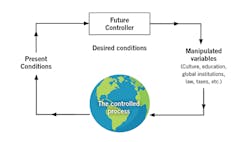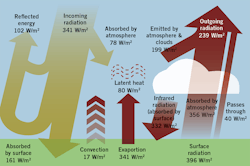Human evolution is a process and therefore the laws of process control apply to it. These laws direct the work of the automation and control (AC) engineers who daily apply model-based control (MBC) to the most complex processes. They determine process dynamics and time constants and calculate where things are headed if left uncontrolled—and what needs to be changed to bring them under control. I just completed a book on this topic, Controlling the Future. In my new book, I apply these laws to the complex processes of climate change and to the impact of uncontrolled artificial intelligence (AI).
Five hundred years ago, society's view of the universe was not yet ready for Galileo and he ended up under house arrest. It took centuries for his scientific discoveries to be accepted. Today, once again, society is not yet ready to accept the predictions of scientists. This time, it's about the consequences of inaction in response to global warming (GW), but this time science doesn't have centuries to make its position accepted. The purpose of this book is to support the scientific view by showing the facts, and applying the laws of the AC profession to evaluate the nature of the GW process and ways to control it.
The future controller
In case of the “future control loop,” the controlled variables are the present conditions on the planet and the manipulated variable is human behavior (Figure 1). These two interact because the error (the difference between the desired and actual conditions) can only be eliminated if we change the manipulated variable—human behavior. For this reason, I'll analyze where the present conditions will take us if we leave the GW process uncontrolled and what needs to change to bring it under control.
When analyzing the GW process, it becomes obvious that mankind has arrived at a critical junction on the road of its evolution. Up to this point, human evolution was mostly directed by nature. This is now changing. From now on, we will have a much greater influence on our own evolution than before. If at this juncture we take the right turn, if we bring GW and AI processes under control, the road will take us to a clean and sustainable future. But if we take the wrong turn—the one that should have a "dead end" sign—if we leave these processes uncontrolled, human civilization may just follow that of the dinosaurs.
The first law of the AC profession is that to control a process, we must fully understand it. Therefore, I'll show that the GW process is the sum of many sub-processes and feedback effects, the size and dynamics of which combine into the overall GW process. I'll describe some feedback processes, the effects of which are bidirectional, others that are self-regulating or self-accelerating, and I'll show the effects of their error-integrating nature, their time constants, dead times, capacities and inertia.
The global heat balance process
GW is a heat balance process. The Earth is rotating in outer space, which is nearly at absolute zero temperature and fully evacuated. If we neglect the Earth's insignificant internal heat generation, the energy input of the Earth comes only from the Sun, amounting to an average radiation of 341 W/m². Thirty percent of that energy is reflected back into space, while the remaining 70% is absorbed by the atmosphere and by the surface of the Earth (yellow arrows in Figure 2). All hot objects emit radiation if their surroundings are colder. Energy balance is established when this energy leaving to outer space (red arrows in Figure 2) is equal to the solar energy absorbed by the Earth and its atmosphere. In other words, when the amounts of heating and cooling are the same, the temperature of the Earth stays constant.
Figure 2: The heat budget of the Earth is balanced when the incoming solar energy (341 W/m2) is the same as the sum of the outgoing energies (102 + 239 = 341 W/m2).
To our knowledge, the Earth is the only livable planet because, when it's in thermal balance, the resulting temperature can support life. In contrast for example, the average temperature on the Moon varies from -298 ºF (-183 ºC) at night to 224 ºF (106 ºC) during the day. As the Earth moved out of ice ages over the past million years, the global temperature rose a total of 4 to 7 ºC. Mean surface temperatures over the last 25 years have been higher than in any comparable period since 1600 A.D. The temperature on Earth is livable because of its atmosphere. It's this atmosphere that maintained the heat balance of our planet, which was about 14 ºC until the Industrial Revolution, and is about 15.1 ºC today. This rise is the GW to date, which will continue until the incoming and outgoing energies are rebalanced.
The reason why the incoming energy increased was that humans started to burn fossil fuels, which emitted greenhouse gases. These gases reflected more of the heat radiated by the Earth back to our planet, raising its temperature. During the industrial age, the carbon dioxide concentration in the atmosphere increased from 280 ppmv to 417 ppmv, meaning the quantity of carbon dioxide in the atmosphere increased by about 1 trillion tons. This emission continues at a yearly rate of about 37 billion tons, which means daily emissions per person on Earth is about 12 kg (28 lb).
Of all emissions, 20% is absorbed by the oceans, 30% is absorbed by plants and 50% stays in the atmosphere. The present GW is about 1.1 ºC and is still increasing by about 0.25 ºC (0.45 ºF) every decade. As will be seen later, this rate will further increase, not only because of new sources like wildfires, but also because a number of positive-feedback processes will be triggered as the ice and permafrost melt. So, when somebody says a GW of 1.1 ºC is not that much, keep in mind that the global temperature before the industrial age was 14 ºC and that it has increased by 1.1 ºC (8%).
Integral effect and self-regulation
GW is caused by more heat entering the Earth than leaving it. This imbalance is caused by the accumulation of greenhouse gases in the atmosphere that reflects more heat back to Earth. This accumulation is like the integral error build-up in process control. The accumulated carbon that's already in the atmosphere doesn't disappear but stays there for decades or centuries. Therefore, GW will continue even after we've completely stopped burning fossil fuels. Actually, it will only stop rising when the global temperature reaches the level that causes the heat reflection back into space (cooling) to equal the greenhouse effect (heating).
This self-regulation will reestablish the heat balance of the planet, but only when the incoming and outgoing energies have equalized. The question is: how high does the temperature need to rise before this happens, and how long will it take to get there? Actually, as GW increases other sub-processes will be triggered, further accelerating the rate of temperature rise. In the AC profession, we refer to this phenomenon as the positive-feedback effect.
In Part 2 of this column, I'll focus on the size and dynamics of the various feedback effects to show how long and at what temperature the Earth's heat balance is likely to be reestablished.
About the Author
Béla Lipták
Columnist and Control Consultant
Béla Lipták is an automation and safety consultant and editor of the Instrument and Automation Engineers’ Handbook (IAEH).

Leaders relevant to this article:



